
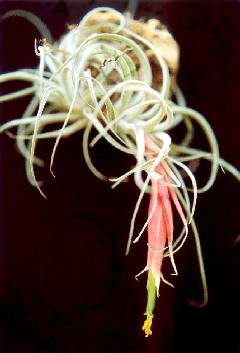
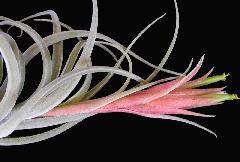
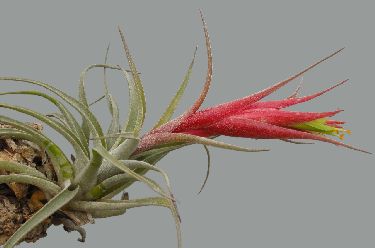
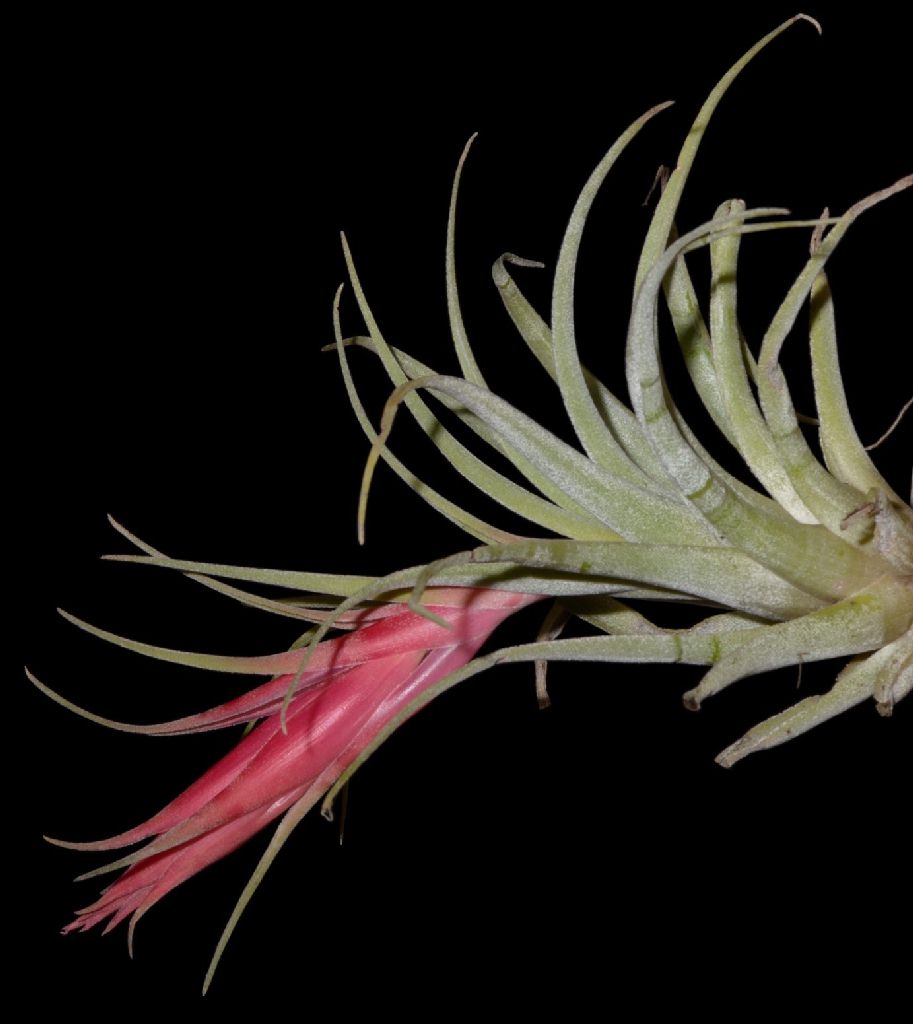
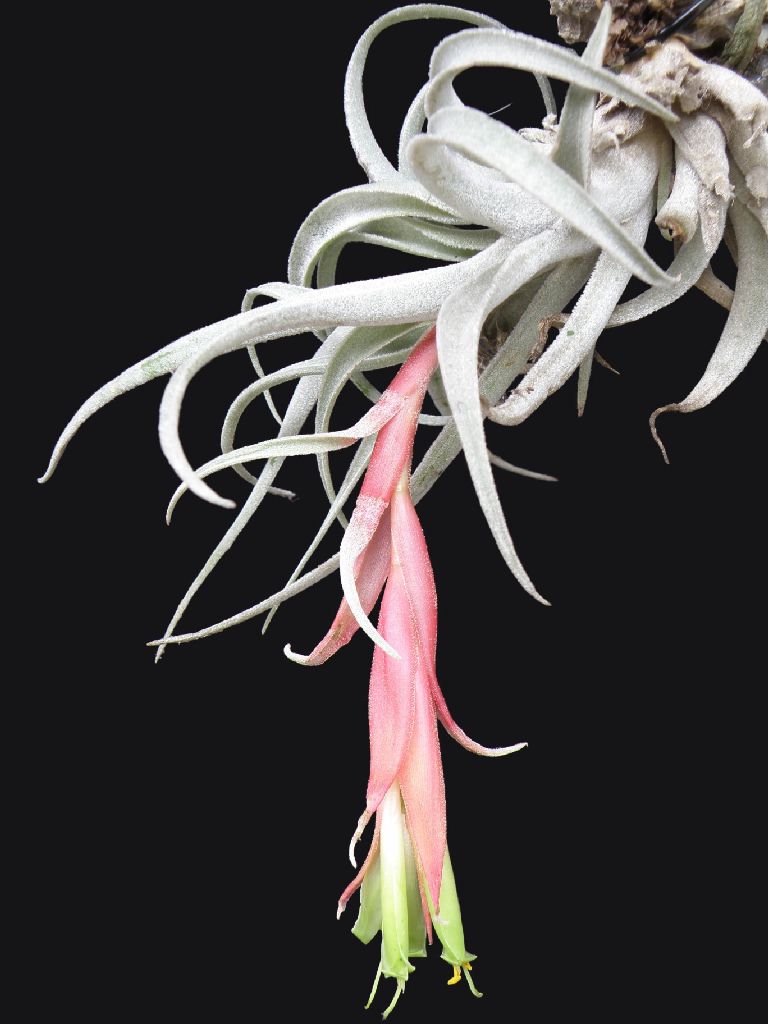
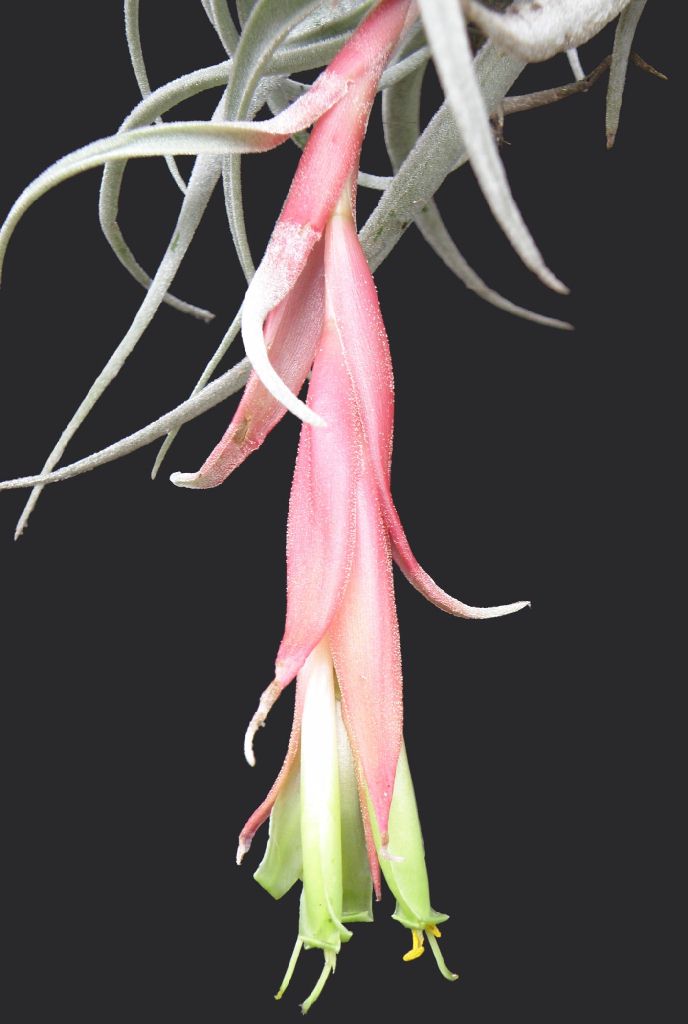
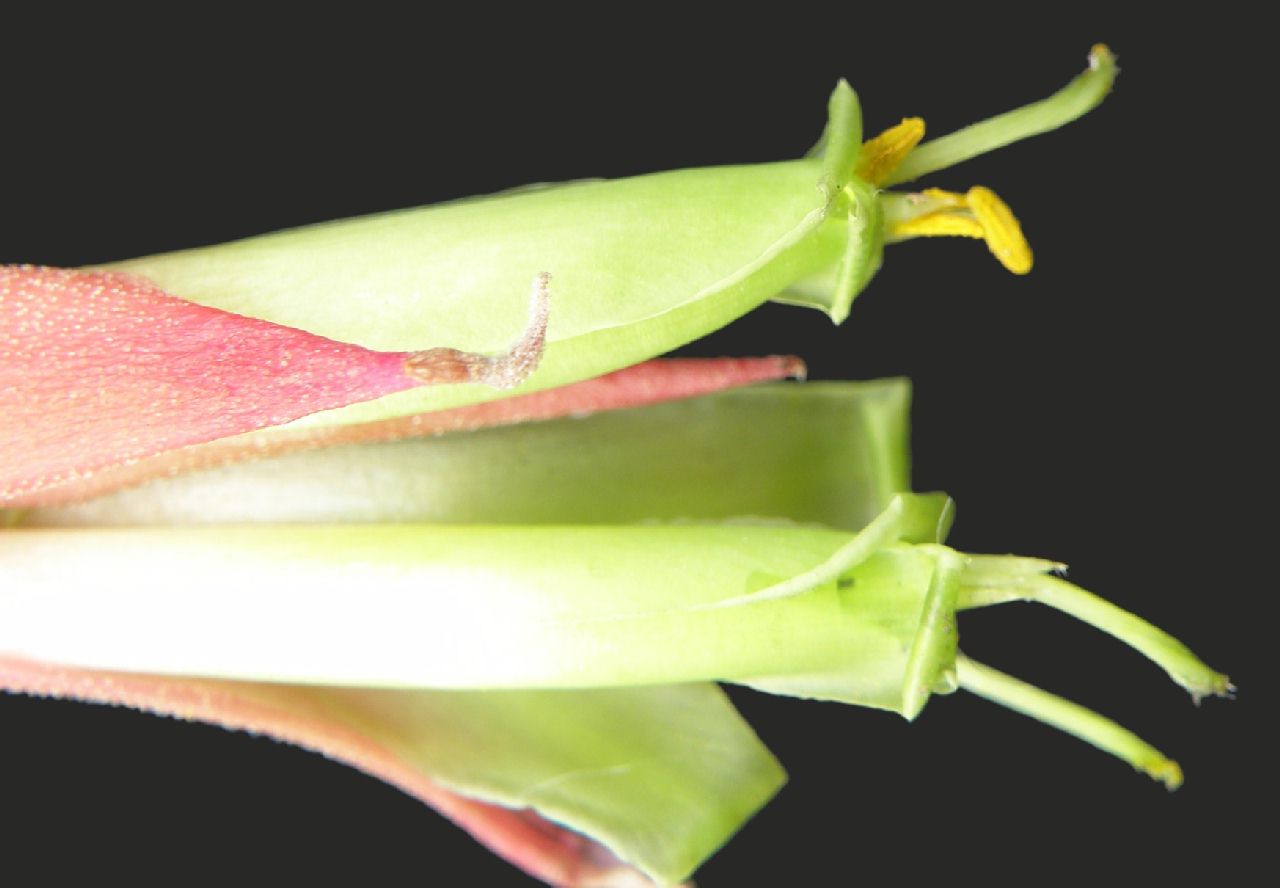
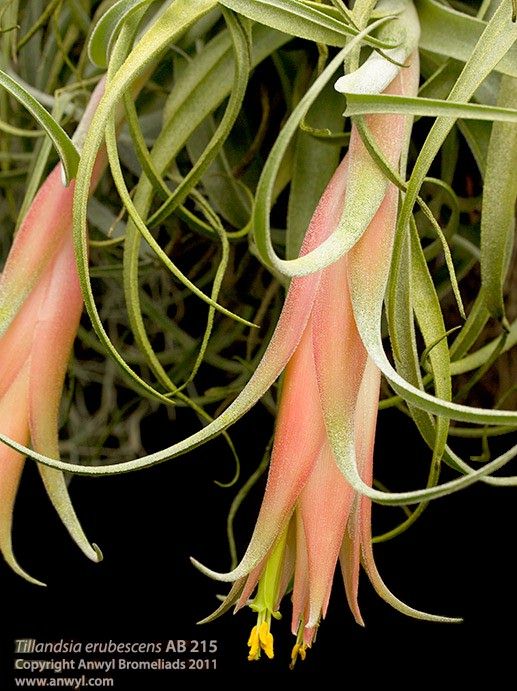
Desc from S&D p1003-5 See also JBS 1981 p173
Plants stemless or short-caulescent, often aggregated in dense masses, 13-22 cm high. Leaves numerous, densely polystichous with the blades often secund and recurved, to 2 dm long, covered with a coat of coarse cinereous subappressed scales;
Blades merging imperceptibly with the inconspicuous oblong sheaths, narrowly triangular, attenuate, involute-subulate toward apex, 5-15 mm wide.
Scape erect or decurved, slender, equaling or shorter than the leaves;
Scape-bracts erect, densely imbricate, the lower foliaceous, the upper ovate with a short foliaceous blade, subinflated, membranaceous, roseate, sparsely lepidote, becoming glabrous.
Inflorescence usually simple and polystichous-flowered but sometimes compound at base, few-flowered, densely ellipsoid or fusiform, to 9 cm long and 3 cm in diameter; axis short, straight, lepidote;
Primary bracts like the upper scape bracts, strict, ample, acute, to 75 mm long, much exceeding the sepals or the axillary spike;
Spike 1-flowered or rarely 2-flowered, the acute membranaceous floral bracts about equaling the sepals;
Flowers erect, subsessile.
Sepals lanceolate, acute, 25-35 mm long, membranaceous, white, strongly nerved, glabrous, equally short-connate, the posterior carinate;
Petals tubular-erect, linear, 7 cm long, pale green;
Stamens and pistil exserted.
Capsule cylindric, acute; about equaling the sepals.
Type. Hartweg 223 (holotype K; isotypes B, BM, GH, P), Bolanos, Jalisco, Mexico. DISTRIBUTION. Epiphytic and saxicolous, 1500-2550 m alt, Mexico.
MEXICO. CHIHUAHUA: Cieneguita Ranch, 27° 15' N, 107° 44' W, 11 Mar 1945, Hewitt 38 (GH); Sierra Charuco, Apr 1948, Gentry 8100 (US); Quiare, Creel, 15 Sep 1957, Knobloch 476 (US). NUEVO LEON: Pueblo Galeana, 10 May 1934, Muller 283 (GH); JuI 1934, Pennell I7212 (PH, US); 29 Ju1 1936, Taylor 321 (F, GH, TEX, US); Montemorelos, 21 Aug 1939, Muller 2940 (GH). SINALOA: Los Pucheros, Sierra Surotato, Mar 1945, Gentry 7250 (GH, US); Badiraguato, 2 Nov 1969, Breedlove & Kawahara 16834 (DS, US). DURANGO: Santiago Papasquiaro, 1896, Palmer 86 (GH, NY, UC, US); Sianori, 1924, Ortega 5399 (GH, US). ZACATECAS: Chalchihuites, 14 Jan 1964, Jones 1041 (MICH). SAN LUIS POTOSI: d'Aoust 683 (P); Rayon, 17 Aug 1891, Maury 7094 (GH); Alvarez, May 1905, Palmer 588 (F, GH, NY, UC, US); Dec 1924, Orcutt 1797 (US); San Luis Potosi, 18 Sep 1954, Rzedowski 4625 (IPMEX); La Salitrera, Zaragoza, 7 Jul 1955, Rzedowski 6070 (IPMEX); Canada Grande, s d, Robinson 92 (US); JALISCO: Bolanos, Sep 1897, Rose 3015 (US). GUANAJUATO: Jaral de Berrio, Schumann 1576 (GH, US); Santa Rosa, Dec 1902, Duges s n (GH); Xichu to San Luis de la Paz, 14 June 1957, McVaugh 14808 (MICH, US). HIDALGO: Epazoyucan, 14 Jun 194 7, Moore 3059 (BH, GH, US); Pachuca, 11 Mar 1954, Troll 395 (M). PUEBLA: Puebla, 16 Dec 1910, Arsene 5743 (BM, GH, NY, US); Esperanza, s d, Purpus 5335 (G); Alchichica, 10 Apr 1957, Foster & Van Hyning 2985 (US). TLAXCALA: Mount Malinche, 16 May 1893, Nelson 5 (US). MORELOS: Amecameca, Jan 1890, Maury 3212 (F, GH). MEXICO: Santa Fe, 23 Mar 1899, Pringle 8094 (GH, US); 11 Ju11901, 9613 (GH, US); Rose & Hay 5372 (US); Montes de la Gavia, 23Jan 1932,Frijderstrijm & Hultin 346 (S); Nepantla, 17 May 1953, Matuda 28710 (MEXU, US). DlSTRICTO FEDERAL: Guadalupe, 22 Aug 1865, Bourgeau 894 (GH, P, US); Valley of Mexico, s d, Bourgeau 1021 (P); Tultenango, 31 Oct 1892, Pringle 4328 (F, GH, US); Llano Grande, 6 Aug 1950, Matuda 18860 (MEXU, US); Tonatico, 11 Jan 1953, Matuda 27909 (MEXU, US). OAXACA: Tehuantepec, May 1952, Bravo 6 (MEXU, US). WITHOUT EXACT LOCALITY: Karwinsky s n (M); Kienast s n (C); Aug 1854, Schaffner 244 (W).
Tillandsia erubescens Schldl. 1845 var. arroyoensis Weber & Ehlers J Brom Soc 33: 30-1. 1983
(Now species in own right see Espejo & Lopez-Ferrari, comb. et stat. nov.-in Selbyana 25(1); 33-96. 2004)
Tillandsia erubescens Schldl. 1845 var. patentibracteata Weber & Ehlers Var nova in JBS 1983 p31
Plant flowered 25 cm long (expanded),
Leaves to 18 cm long but shorter than the long pendulous inflorescence,
Scape to 14 cm long,
Scapebracts many times longer than the internodes, 45-55 mm long, the lower with long subulate blades, the upper long lanceolate, acuminate, membranaceous, roseate, very dissite lepidote, spreading;
Inflorescence 7 cm long, subdense polystichous 6-flowered.
Flower bracts like the upper scapebracts, spreading, roseate, membranaceous, minutely apiculate, only at apex indistinct lepidote;
Sepals oblong-ovate, subacute, equal, free, ecarinate, to 30 mm long and 12 mm wide, membranaceous, glabrous, whitish, at apex pale roseate;
Petals 52 mm long, white, at apex pale yellowish-green, stamens and pistil exserted.
This beautiful, large variety is distinguished from the type by its long pendent not fusiform inflorescence and the spreading bracts.
HOLOTYPE: Mexico: Durango, on the road between Durango and Mazatlan, leg. Renate Ehlers March 1981, flowered in cultivation Hort. Weber 27.2 1982 - WEB 429.
The Riddle of Tillandsia erubescens Schldl. has been solved! by WILHELM WEBER in J Brom Soc. 31(4): 173-5. 1981
For many years Tillandsia ionantha Planch. 1855 was considered to be identical with Tillandsia erubescens Schldl. 1845 ("1844") and was cultivated under this name in collections. Carl Mez in his bromeliad monograph of 1935 in Engler's Pflanzenreich indicated that Tillandsia ionantha was synonymous with Tillandsia erubescens Schldl., and also in the first edition of Walter Richter's Bromeliaceen - Zimmerpflanzen Von Heute und Morlgen the well known Tillandsia ionantha was still called Tillandsia erubescens.
But already in 1941 L.B. Smith determined that a study of the original description of Schlechtendal in LINNAEA Vol. 18, 1845 ("1844"), p. 427-429, indicates that Tillandsia erubescens cannot be identical with Tillandsia ionantha. He wrote in his Studies in the Bromeliaceae XIII in LILLOA VI; 1941, p. 384:
Tillandsia ionantha Planch. in Fl. des Serres X, 101, t. 1006 (1855).
T. erubescens Schlecht. sensu Mez in Engl. Pflanzenreich, IV. Fam. 31, 496, fig. 98 (1935).
In his treatment of Tillandsia erubescens in the Pflanzenreich, Mez nowhere cites any Schiede material which was the basis of the original description. Schlechtendal's description contains the following phrases:
"Eine nur ½ Fuss hohe Art," ... "etwa ¾ Zoll dicken Aehre" ... "die Blumen erscheinen getrocknet gelb"; and none of these are easily reconciled with Tillandsia ionantha. Yet Mez reduces T. ionantha to the synonymy of the T. erubescens.
It is probably best for the present to place T. erubescens on the dubious list and hope for the appearance of the type later. Judging from the description there is some possibility that T. erubescens is the same as T. benthamiana.
Since that time the plant so well known to all of us and widely found in collections again bears the valid name Till. ionantha Planch. 1855; on the other hand Till. erubescens Schldl. is still in the new monograph of the Tillandsioideae in the FLORA NEOTROPICA by L.B. Smith in the list of dubious species.
But which species was it that Schlechtendal actually described as Till. erubescens? The original description in LINNAEA 1844 (the last pamphlet of this year with the bromeliad descriptions did not appear until 1845) runs as follows (original text and spelling):
S. Angel, S. Bartolo (Schiede). Eine nur ½ Fuss hohe Art, dicht mit breitrandigen und am Rande etwas zerschlitzten Silberschuppen bedeckt, die nur auf Kelch und Blumenkrone fehlen. Die Blatter, unten nur ½ Zoll breit und 3-5 Zoll lang, gehen allmahlig und dadurch, dass sie sich mit ihren Randern Einrollen, scheinbar noch schneller in die dunne, wie pfriemformige Spitze aus, meist sind sie gekrummt, und zwar sind die ausseren oft nach einer Seite gewendet, stark herabgebogen, Nerven bemerkt man an ihnen wegen der Schuppen nicht. In ihrer Mitte erhebt sich der bis zur Aehre etwa 3 Zoll hohe Stengel, der aber wegen der ihn bedeckenden Blattscheiden nicht zu sehen ist, these Stengelblatter sind den untern Blattern ganz ahnlich, uur etwas kurzer, sie gehen nach oben allmahlig in die Bracteen uber, von denen die unteren keine Blumen bringen, ihr scheidiger Theil ist schon bedeutend vergrossert und rosenroth gefarbt, und ihre Lamina, welche bei den hohern Bracteen sich nur als eine immer kurzer werdende Ausspitzung zu erkennen giebt, ist noch langer, und bringt besonders das Aussehen hervor, als waren die Blatter wohl langer, als der bluhende Stengel, wahrend dieser eigentlich etwas langer, als die untern, langsten Blatter ist. Diese rosenroth angelaufenen Bracteen sind auf ihrer Aussenseite mit zerstreuter stehenden Silberschuppen besetzt, die nach dem Rande hin auch wohl dichter stehen und an diesem selbst etwas grosser sind, was nebst der zarten Textur und den dunnen, weisslichen Randern der im Ganzen etwas lanzettlichen, in der Mitte etwa ¾ Zoll dicken Aehre etwas sehr zartes giebt, wodurch sie an T. vestita erinnert, deren Aehren aber viel schmaler und langer aus den Blattern hervostehendsind. Der Kelch, welcher etwa 14 Linien lang ist, wird ganz von der Scheide verborgen, er ist daher auch ganz dunnhautig, weisslich und kahl, seine 3 Theile sind beim Bluhen ineinander gewickelt, und umgeben den untern Theil der Blumenkrone, sie werden von mehreren Nerven durchzogen, welche sich durch kurze Bogen mit einander vereinigen, so class nahe der Spitze nur drei, zuletzt aber nur 1 ubrig bleibt, welcher auslauft. Die Blumen ershceinen getrocknet gelb, und die Staubgefasse, wie fast bei allen, geschlangelt, was wohl Folge des Trockenwerdens ist und dann nicht in den Beschreibungen erwahnt werden durfte; die schwefelgelben Staubbeutel sind schmal elliptisch, daum mehr als eine Linie lang. Der Griffel ist mit seinen 3 spiralformig, dicht gedrehten Enden um mehrere Linien langer, als die Staubgefasse. Kapsel und Saamen sah ich nicht. Auch these Art wachst mit T. usneoides zusammen.
The good offices of Inspector Juergen Roeth of the Botanical Garden at Halle and the cooperation of the custodian of the Herbarium of the University of Halle, Dr. K. Werner have made it possible for me to borrow from the Bromeliaceae collection of the herbarium of Schlechtendal, and I am now in the process of examining this interesting and valuable material. The complete results will be published later. Here follow only preliminary findings on some necessary name changes of species that are commonly found in collections.
Among Schlechtendal's specimens I found the long missing type specimen of Tillandsia erubescens, recognized by the hand written label of the collector Schiede: "101. Tillandsia, S Angel, S Bartolo." The accompanying photograph shows the three type specimens. The subsequent description did indeed show Tillandsia erubescens Schldl. 1845 identical with Tillandsia benthamiana Klotzsch ex Baker 1888 described later, as L.B. Smith already assumed. Therefore the priority rule makes the following name change mandatory:
Tillandsia erubescens Schlechtendal in LINNAEA 18 (" 1844") 1845, p. 427-29 non Wendl. 1854 nec sensu Mez 1935
Syn.: Till. vestita sensu Bentham 1840 Non Willd. 1830 nec Schl. & Cham. 1831 Anoplophytum vestitum Beer 1857 e.p.
Till. benthamiana Klkotzsch ex Baker 1888 Till. hartwegiana E. Morr. ex Baker 1889 HOLOTYPUS: Schiede 101, Mexico, S. Angel, S. Bartolo; HAL 45608
And that solves this old puzzle. But how did a mix-up occur in these two species that are so different? In 1854 H. Wendland, probably not knowing of Schlechtendal's earlier description of the same name, described in Otto & Dietrich's Allgemeine Gartenzeitung, Vol 22, p. 153 a Tillandsia erubescens which was in cultivation under this name in the Hortus Herrenhausen (Hannover). In the book Die Familie der Bromelien (1847) the Austrian botanist J.G. Beer presented the genus Pityrophyllum and on page 79 said (original text and spelling):
Pityrophyllum erubescens Beer
Tillandsia erubescens Hort. Herrenhausen
Till. ionantha Planch. Flore van Houtte 1855 tab. 1006
Diese schone kleine Pflanze bildet durch die mehreren Seitensprosse zierliche Rasen. Vor der Bluhtezeit ist die Pflanze ganz gleichmassig dunkel olivengrun, mit weiss kleiigem Anfluge; die Oberhaut der Laubblatter sehr fein warzig, fast rauh, besonders an den stumpfen Randern mehr weisslich erscheinend, mit spitzem Ende. Blattflache dicklich, am Grunde umfassend, 2½" lang, in Mitte ¼" breit. Zur Bluthezeit farben sich die sammtlichen Herzblatter lebhaft roith an den Spitzen, sonst schmutzig lilaroth. Bluthen einzeln, rohrenformig, mit etwas zuruckgeschlagenen Zipfeln, bei 1½" lang, 3" dick, lebhaft violett gefarbt. Staubblatter aufrecht, etwas vorragend. Griffel aufrecht, am Ende dreitheilig, mehr hervorragend als die Staubblatter ....
This description clearly depicts the well-known Tillandsia ionantha Planch. 1855. Even then it must have been grown commonly in botanical gardens, because Beer also mentions that he owned several specimens of this "cute form." Thus the spread of the name Till. erubescens instead of Till. ionantha started in European gardens, and Mez used this name in his monograph while mistakenly assuming that Schlechtendal's erubescens was identical with Wendland's.